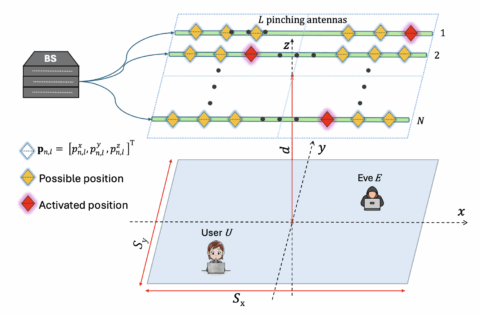Master Thesis — Pinching Antenna Systems for Low-Latency and Secure IoT Communications Under Finite Block-Length Constraints
Topic:
Pinching Antenna (PA) systems have recently gained attention as a promising alternative to conventional multiple-input multiple-output (MIMO) architectures, offering dynamic spatial reconfigurability with low hardware complexity. By deploying pinching antennas along low-loss waveguides, PAS can flexibly steer beams and adapt the antenna layout in space. This spatial agility makes PAS particularly well-suited for modern wireless applications that require secure, fast, and reliable connectivity.
One key application area is short-packet communication for critical Internet of Things (IoT) devices, such as factory robots, sensors, and augmented reality headsets. In these scenarios, data arrives unpredictably and must be transmitted immediately while meeting strict reliability and latency constraints. Traditional capacity models fail to capture this behavior because they assume infinite block-lengths. In contrast, finite block-length (FBL) theory characterizes more accurately the trade-off between latency, reliability, and achievable rate. Furthermore, to ensure secure communication in the presence of passive eavesdroppers, artificial noise (AN) can be incorporated into the system.
In this thesis, a PA system for secure, short-packet, low-latency communication under finite block-length constraints should be designed and optimized. The optimization focuses on reconfiguring the positions of PA along the waveguide and designing precoders to improve the packet delivery success probability under strict latency and reliability requirements, while ensuring physical layer security. This joint design problem poses unique challenges and opens new opportunities in PAS research, especially for future wireless networks supporting critical IoT applications.
Guidelines for the project:
- Conducting a comprehensive literature review on PAS.
- Modeling the PAS channel, accounting for both the waveguide and free-space components.
- Formulating and solving a joint optimization problem for beamforming and PA positioning under FBL constraints.
- Simulating and evaluating the system performance in MATLAB.
If successful, this work may lead to a journal and/or a conference paper.
Prerequisites:
- Background in communications and signal processing
- Background in convex optimization
- Programming skills (e.g., experience in MATLAB)
The complete project description can be found here. In case you are interested in pursuing this thesis, please contact Ata Khalili (ata.khalili@fau.de) or Brikena Kaziu (brikena.kaziu@fau.de).
